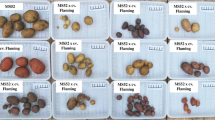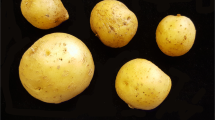Summary
Many plants resistant to methomyl (Lannate), an insecticide which selectively damages maize with the Texas (T) type of cytoplasmic male sterility (CMS-T), were obtained by in vitro selection and also without selection. The selection procedure used 0.6–0.7mM methomyl and callus from CMS-T versions of several field and sweet corn genotypes (W182BN, Wf9, P39, MDM1, SW1 and hybrids of SW1, IL766A1, IL766A2, and 442 with W182BN-N). Addition of 1 mM methomyl to the regeneration medium greatly reduced recovery of methomyl-sensitive escapes. Resistance was linked with reversion to male fertility and maternally inherited. Most progeny of resistant plants exhibited stable maternally inherited resistance for two generations in field tests. First-generation progeny of seven culture-derived plants segregated for resistance and sensitivity; this suggests that ears of these seven regenerants were cytoplasmically chimeral. Resistance to methomyl was associated with resistance to T toxin from Helminthosporium maydis race T and with changes in mitochondrial physiology. Prolonged culture (14–16 months versus 6–8 months) increased the frequency of resistance among both selected and non-selected regenerants. Little or no resistance was found among regenerants from certain genotypes. Selection with methomyl may be useful for production of improved sweet corn lines and as a source of mitochondrial mutants. This system is also convenient for studies of the effects of nuclear background and of culture and selection systems on the generation of cytoplasmic mutants.
Similar content being viewed by others
References
Beckett JB (1971) Classification of male-sterile cytoplasms in maize (Zea mays L.). Crop Sci 11:724–727
Bouthyette PY, Spitsberg V, Gregory P (1985) Mitochondrial interaction with Helminthosporium maydis race T toxin: Blocking by dicyclohexylcarbodiimide. Exp Bot 36:511–528
Brettell RIS, Goddard BVD, Ingram DS (1979) Selection of Tms-cytoplasm maize tissue cultures resistant to Drechslerea maydis T-toxin. Maydica 24:203–213
Brettell RIS, Thomas E, Ingram DS (1980) Reversion of Texas male-sterile cytoplasm maize in culture to give fertile T-toxin resistant plants. Theor Appl Genet 58:55–58
Chu CC, Wang CC, Sun CS, Hsu C, Yin KC, Chu CY (1975) Establishment of an efficient medium for anther culture of rice through comparative experiments on the nitrogen sources. Sci Sin 16:659–688
Dewey RE, Levins CS III, Timothy DH (1986) Novel recombinations in the maize mitochondrial genome produce a unique transcriptional unit in the Texas male-sterile cytoplasm. Cell 44:439–449
Dewey RE, Timothy DH, Levings CS III (1987) A mitochondrial protein associated with cytoplasmic male sterility in the T cytoplasm of maize. Proc Natl Acad Sci USA 84:5374–5378
Dewey RE, Siedow JN, Timothy DH, Levings CS III (1988) A 13-kilodalton maize mitochondrial protein in E. coli confers sensitivity to Bipolaris maydis toxin. Science 239:293–295
Dixon LK, Leaver CJ, Brettell R, Gengenbach B (1982) Mitochondrial sensitivity to Drechslera maydis T-toxin and the synthesis of a variant mitochondrial polypeptide in plants derived from maize tissue culture with Texas male-sterile cytoplasm. Theor Appl Genet 63:75–80
Duncan R, Willams ME, Zehr BE, Widholm JM (1985) The production of callus capable of plant regeneration from immature embryos of numerous Zea mays genotypes. Planta 165:322–332
Duvick DN (1958) Yields and other agronomic characteristics of cytoplasmically pollen sterile corn hybrids, compared to their normal counterparts. Agron J 50:121–125
Duvick DN (1965) Cytoplasmic pollen sterility in corn. Adv Genet 13:1–56
Earle ED, Gracen VE, Yoder OC, Gemmill KP (1978) Cytoplasm-specific effects of Helminthosporium maydis race T toxin on survival of corn mesophyll protoplasts. Plant Physiol 61:420–424
Earle ED, Gracen VE, Best VM, Batts LA, Smith ME (1987) Fertile revertants from S-type male-sterile maize grown in vitro. Theor Appl Genet: 74:601–609
Escote LJ, Gabay-Laughnan SJ, Laughnan JR (1985) Cytoplasmic reversion to fertility in CMS-S maize need not involve loss of linear mitochondrial plasmids. Plasmid 14:264–267
Escote LJ, Gabay-Laughnan SL, Laughnan JR (1988) Reorganization of mitochondrial genomes of cytoplasmic genomes in CMS-S inbred line WF9 in maize. Theor Appl Genet 75:659–667
Fauron CM-R, Abbott AG, Brettell RIS, Gesteland RF (1987) Maize mitochondrial DNA rearrangements between the normal type, the Texas male sterile cytoplasm, and a fertile revertant CMS-T regenerated plant. Curr Genet 11:339–346
Forde BJ, Leaver CJ (1980) Nuclear and cytoplasmic genes controlling synthesis of variant mitochondrial polypeptides in male-sterile maize. Proc Natl Acad Sci USA 7:418–422
Gengenbach BG, Green CE (1975) Selection of T-cytoplasm maize callus cultures resistant to Helminthosporium maydis race T pathotoxin. Crop Sci 15:645–649
Gengenbach BG, Green CE, Donovan CM (1977) Inheritance of selected pathotoxin resistance in maize plants regenerated from cell cultures. Proc Natl Acad Sci USA 74:5113–5117
Gengenbach BG, Connelly JA, Pring DR, Conde MF (1981) Mitochondrial DNA variation in maize plants regenerated during tissue culture selection. Theor Appl Genet 59:161–167
Gregory P, Earle ED, Gracen VE (1980) Effects of purified Helminthosporium maydis Race T toxin on the structure and function of mitochondria and protoplasts. Plant Physiol 66:477–481
Humaydan HS, Scott EW (1977) Methomyl insecticide selective phytotoxicity on sweet corn hybrids and inbreds having the Texas male sterile cytoplasm. HortScience 12:312–313
Kennell JC, Wise RP, Pring DR (1987) Influence of nuclear background on transcription of a maize mitochondrial region associated with Texas male-sterile cytoplasm. Mol Gen Genet 240:399–406
Koeppe DE, Cox JK, Malone CP (1978) Mitochondrial heredity: A determinant in the toxic response of maize to the insecticide methomyl. Science 201:1227–1229
Kono Y, Daly JM (1979) Characterization of the host-specific pathotoxin produced by Helminthosporium maydis race T affecting corn with Texas male-sterile cytoplasm. Bioorg Chem 8:391–397
Kuehnle AR (1988) In vitro selection for methomyl resistance in Texas male-sterile maize (Zea mays L:). PhD thesis, Cornell University
Lemke CA, Gracen VE, Everett HL (1988) A second source of cytoplasmic male sterility in maize induced by the nuclear gene, iojap. J Hered 79:459–464
Levings CS III, Pring DR (1977) Diversity of mitochondrial genomes among normal cytoplasms of maize. J Hered 68:350–354
McNay JW, Pring DR, Lonsdale DM (1983) Polymorphism in mitochondrial DNA “S” regions among normal cytoplasms of maize. Plant Mol Biol 2:177–187
McNay JW, Chourey PS, Pring DR (1984) Molecular analysis of genomic stability of mitochondrial DNA in tissue-cultured cells of maize. Theor Appl Genet 67:433–437
Murashige T, Skoog F (1962) A revised medium for rapid growth and bioassays with tobacco tissue cultures. Physiol Plant 15:473–497
Newton KJ, Walbot V (1985) Molecular analysis of mitochondria from a fertility restorer line of maize. Plant Mol Biol 4:247–252
Pham HN (1980) Nuclear and cytoplasmic control of resistance to Helminthosporium maydis race T and its toxin in corn plants, protoplasts, and mitochondria. PhD thesis, Cornell University
Pring DR, Levings CS III, Conde ME (1979) The organelle genomes of cytoplasmic male-sterile maize and sorghum. In: Davies DR, Hopwood DA (ds) The plant genome. John Innes Charity, Norwich, pp 111–120
Rode A, Hartmann C, Falconet D, Lejeune B, Quetier F, Bensliman A, Henry Y, Buyser J de (1987) Extensive mitochondrial DNA variation in somatic tissue cultures initiated from wheat immature embryos. Curr Genet 12:369–376
Rottmann WH, Brears T, Hodge TP, Lonsdale DM (1987) A mitochondrial gene is lost via homologous recombination during reversion of CMS-T maize to fertility. EMBO J 6:1541–1546
Small ID, Isaac PG, Leaver CJ (1987) Stoichiometric differences in DNA molecules containing the atpA gene suggest mechanisms for the generation of mitochondrial genome diversity in maize. EMBO J 6:865–869
Small ID, Earle ED, Escote-Carlson LJ, Gabay-Laughnan S, Laughnan JR, Leaver CJ (1988) A comparison of cytoplasmic revertants to fertility from different cms-S maize sources. Theor Appl Genet 76:609–618
Snedecor GW, Cochran WG (1980) Statistical methods. Iowa State University Press, 7th edn. pp 96–98, 192–193
Stamper SE, Dewey RE, Bland MM, Levings CS III (1987) Characterization of the gene urf13-T and an unidentified reading frame, ORF 25, in maize and tobacco mitochondria. Curr Genet 12:457–463
Sugino Y, Miyoshi Y (1964) The specific precipitation of orthophosphate and some biochemical applications. J Biol Chem 239:2360–2364
Umbeck PF, Gengenbach BG (1983) Reversion of male-sterile T-cytoplasm maize to male fertility in tissue culture. Crop Sci 23:584–588
Watrud LS, Hooker AL, Koeppe DE (1975) The effects of nuclear restorer-genes of Texas male-sterile cytoplasm on host response to Helminthosporium maydis Race T. Phytopathology 65:178–182
Wise RP, Fliss AE, Pring DR, Gengenbach BG (1987a) urf13-T of T cytoplasm maize mitochondria encodes a 13-kD polypeptide. Plant Mol Biol 9:121–126
Wise RP, Pring DR, Gengenbach BG (1987b) Mutation to male fertility and toxin insensitivity in Texas (T)-cytoplasm maize is associated with a frameshift in a mitochondrial open reading frame. Proc Natl Acad Sci USA 84:2858–2862
Author information
Authors and Affiliations
Additional information
Communicated by P. Maliga
Rights and permissions
About this article
Cite this article
Kuehnle, A.R., Earle, E.D. In vitro selection for methomyl resistance in CMS-T maize. Theoret. Appl. Genetics 78, 672–682 (1989). https://doi.org/10.1007/BF00262563
Received:
Accepted:
Issue Date:
DOI: https://doi.org/10.1007/BF00262563




